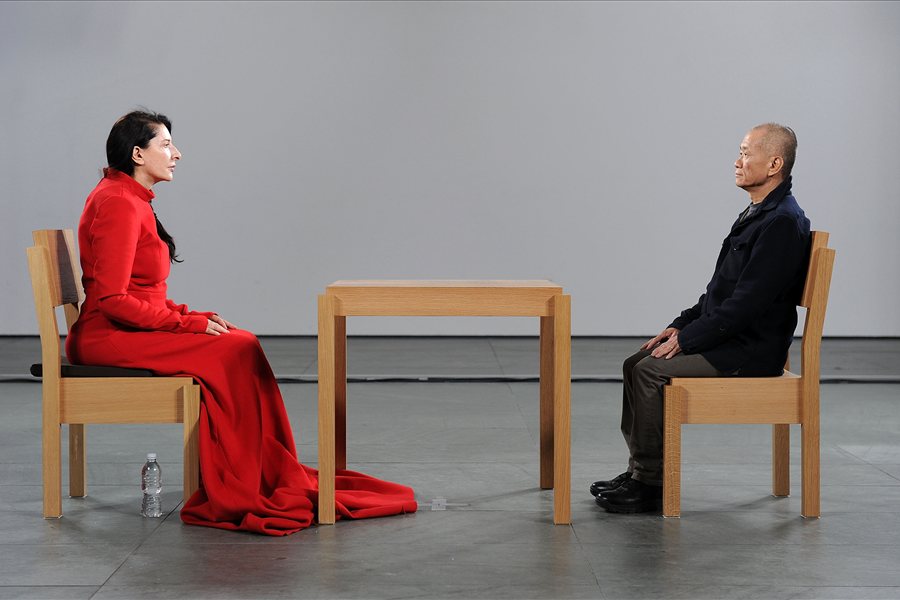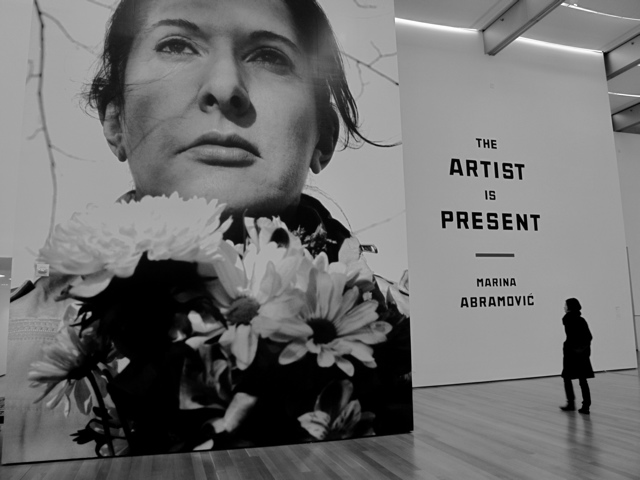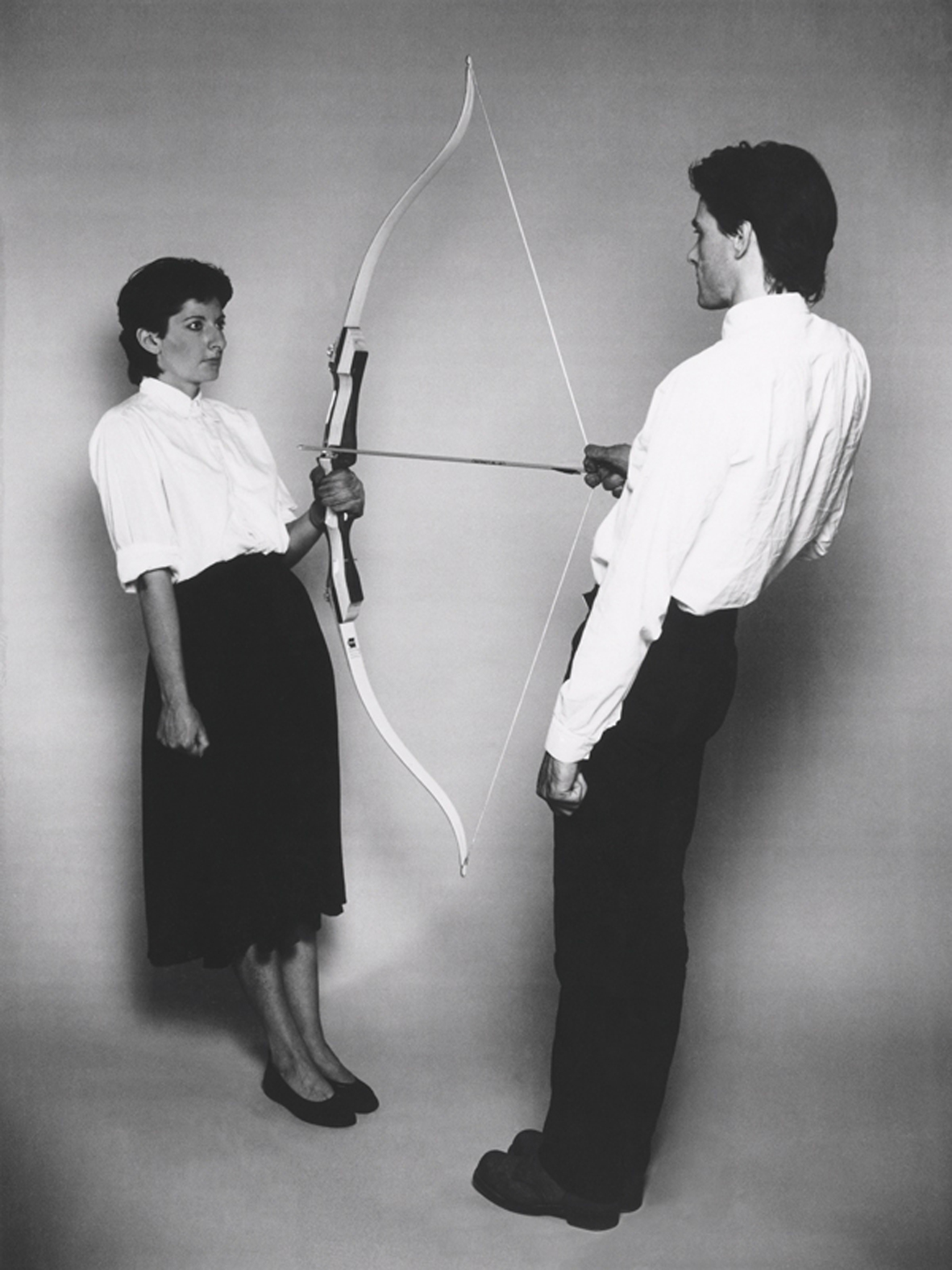

During the spring semester of my sophomore year, a time when I was still very impressionable and not the world-weary upper classman I now consider myself to be, I took an introductory acting class in which I learned the difference between internal and external gazing. At the command of our animated professor, the whole sleep-deprived class would practice switching from the internal gaze—what happens when you’re lost in thought and not paying any attention to what you happen to be staring at—and the external gaze. The external gaze is observant; you switch your attention from interior reflection to awareness of what is in front of you. There is, we learned from watching our classmates make this switch, a noticeable change when someone takes their focus off of their own thoughts and steps out of their private headspace to engage with the perceivable world.
A few years ago, the New York Museum of Modern Art hosted a large retrospective of Serbian artist Marina Abramovic’s career. Considered to be the “grandmother of performance art,” Marina Abramovic has challenged the definition of art through her controversial performance work since the 70s. (Most recently, Abramovic attended Jay-Z’s 6-hour presentation of his new song “Picasso Baby” at the Pace Gallery, where the artist and the rapper danced together and stared at one another in an improvised performance within the performance.)
definition of art through her controversial performance work since the 70s. (Most recently, Abramovic attended Jay-Z’s 6-hour presentation of his new song “Picasso Baby” at the Pace Gallery, where the artist and the rapper danced together and stared at one another in an improvised performance within the performance.)
The centerpiece of the MoMA’s retrospective exhibition was a new piece called The Artist is Present, in which Abramovic sat still and silent all day for three months (a total of about 730 hours—not speaking, not eating, and no one really knows about peeing), inviting audience members to sit across from her and exchange gazes in an “energy dialogue.” Audience members who took turns across from Abramovic stared, frowned, smiled, wept, and fell in love. Watching recordings of the performance, I couldn’t help but be struck by the intentness of Abramovic’s gaze. Because of its simplicity, it’s easy to doubt the effortful genius behind the project, but as Abramovic says, “The hardest thing is actually to do something that is close to nothing.”
Abramovic’s gaze is purely external and, therefore, selfless. In the HBO documentary called Marina Abramovic: The Artist is Present, Abramovic describes the extent to which she lost a sense of herself in the performance. Her language is astonishing. (Abramovic’s English is nearly perfect, but I’ve quoted her here exactly as she expresses herself in the film.)
This feeling of beauty and unconditional love, this feeling of there’s no kind of borders between your body and environment—you start having this incredible feeling of lightness and harmony with yourself. Something becomes, like, holy. I can’t explain. And that other state of mind is exactly what public start feeling—that something is different.
She makes no distinction between life and art, and for her, the present moment is both. The person sitting opposite Abramovic is made part of the art—is, in fact, the object of the art. Rather than the individual gazing at the artist’s work, the artist flips the dynamic on its head and gazes at the individual as the masterpiece. Klaus Biesenbach, MoMA’s Chief Curator, says of the show, “It’s only for you so each and every one had a clean, unique and personal contact with Marina…She is treating actually every human being that she encounters with the same attention and the same respect. That’s pretty shocking.” And it is—audience members are brought to tears by the focused attention that they receive. (There is a tumblr called “Marina Abramovic Made Me Cry,” devoted solely to photos of people who cried while sitting across from her.)

Abramovic likens her position with the audience to a mirror, “It’s not about me anymore. I’m just the mirror of their own self.” However, Abramovic is much more than a mirror because mirrors are never really honest reflections of our outward appearances. They are reflections of all of our pride or insecurity, depending on the day and even the moment—reflections of what we expect to see based on our self-evaluations. We look and we see the disappointing child who never lived up to their parents’ expectations, the insecure friend who pushes others away with their incessant neediness, the emotionally unavailable boyfriend or girlfriend who is incapable of really connecting. When we look at a mirror we do not see a neutral reflection of our appearances, but rather, we find, along with the stubborn wrinkles and pimples, all of our blemishing fears and insecurities staring back in such clear detail that we feel they are confirmed. Mirrors take our emotional baggage and throw it right back at us. Abramovic absorbs the audience’s gaze, laden with anxiety, and gazes back with neither judgment nor expectations, asking nothing in return.
In designing The Artist is Present, Abramovic envisioned the space as “a square of light.” The exhibit also included many recreations of Abramovic’s earlier works, many of which are marked by tension, discomfort and violence. Many of her performances, which were reenacted throughout the rest of the exhibit, aimed to make the audience uncomfortable through oppressive nudity (in “Imponderabilia,” museum-goers are forced to push through two naked bodies that form a narrow doorway), and self-mutilation (a video shows Marina cutting a star into her stomach with a razor blade). Abramovic described her position in the show as “a mountain…stillness in the middle of the hell.” While the brutality and the discomfort was performed again and again all around, the square of light in the middle offered repose and, in Abramovic’s own words, “unconditional love.” You went there to feel your value. Abramovic confesses that her mother never gave her enough love growing up. She created her own safe space in the midst of the struggle of her life—she aimed to give the love she never had, with only a look.
When most people look in the mirror, they can’t help but size themselves up. Everything that appears externally lodges itself internally in our minds where the dim searching lights of our anxious thoughts turn our reflected physical qualities into monstrous shadows that threaten our personalities and identities. The internal gaze is self-focused, and so gazing externally at yourself can only ever be internal. Marina becomes the mirror that reflects only acceptance and love. In her external gaze, you see yourself as the object in her mirror–yet there’s no evaluation. I’m reminded of the story of the rich young ruler in Mark chapter 10, where Jesus looks at him in all of his self-righteous ignorance, in the midst of his heart’s mess, sees only him, and loves him.
[youtube=https://www.youtube.com/watch?v=YcmcEZxdlv4]

COMMENTS
6 responses to “With Only a Look, Marina Abramovic Is Making People Cry”
Leave a Reply













Profound post, Emily.
I will be checking out that documentary as soon as possible.
Absolutely incredible.
Absolutely astonishing. Thank you…